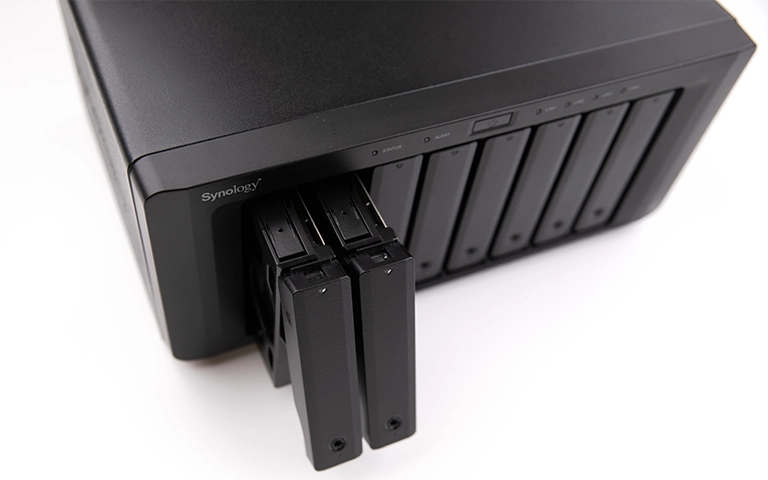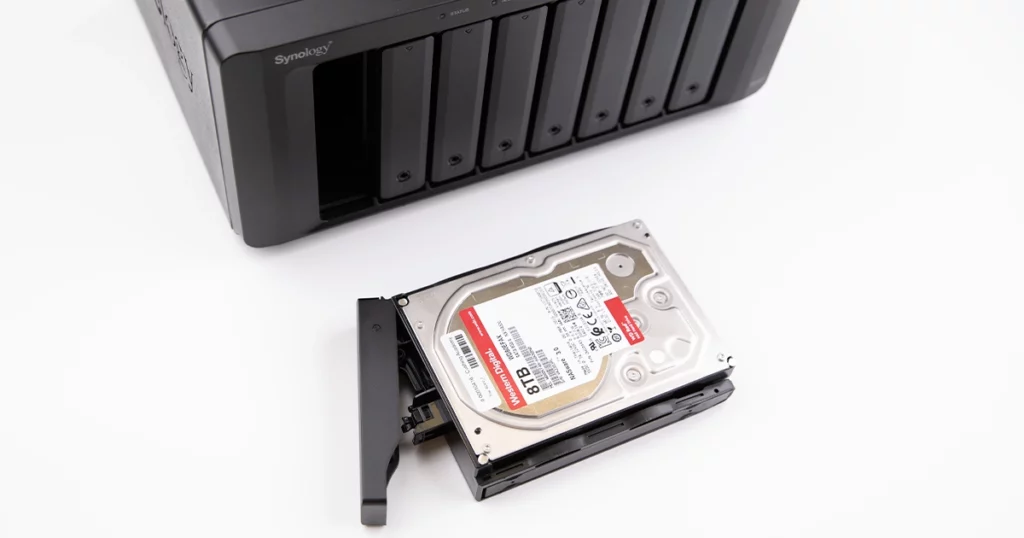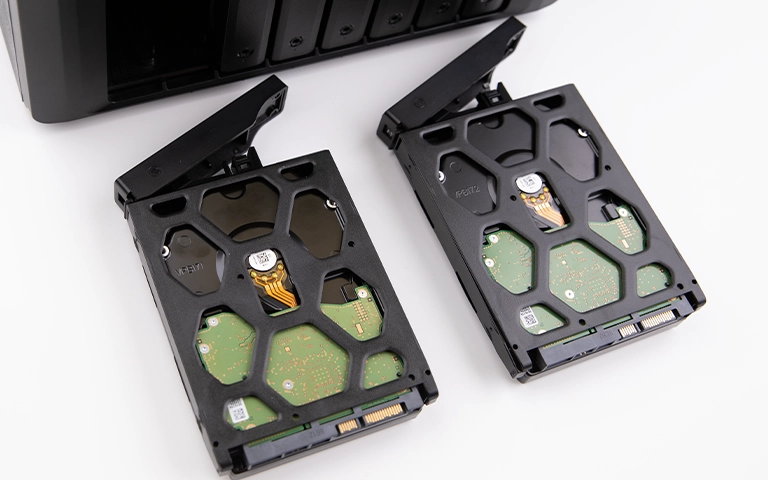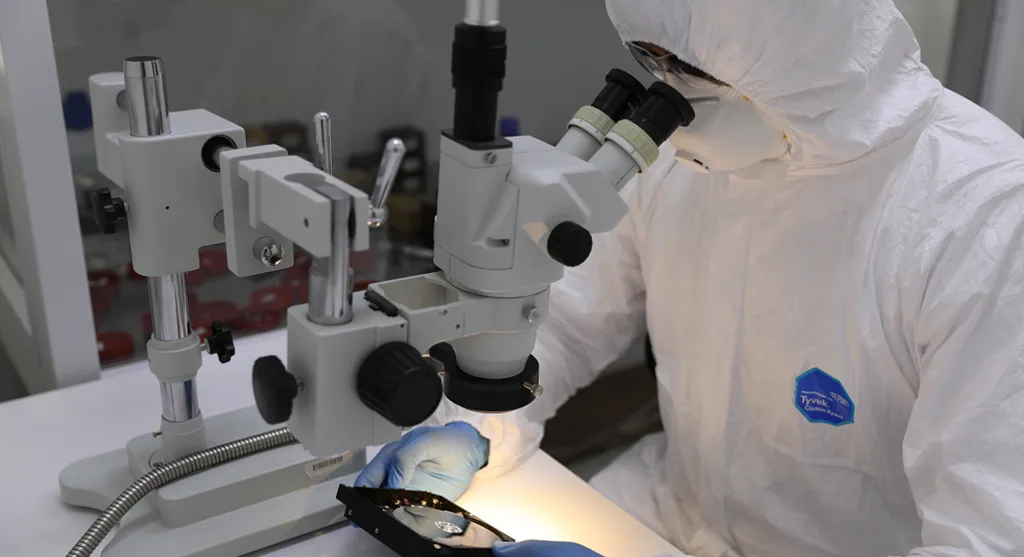A Network Attached Storage (NAS) device is vital for storing and sharing data across your network. When it fails, access to critical files can stop instantly, disrupting both personal and business workflows.
A NAS failure doesn’t always mean permanent data loss, but taking the wrong steps can make recovery harder.
In this guide, you’ll learn what causes NAS failures, how to respond safely, and when to involve professionals to restore your data.
Learn more about common NAS data loss causes.

Common Causes of NAS Failure
NAS failures can occur for many reasons, often involving both hardware and software issues. Recognizing these causes helps you act quickly and reduce the risk of permanent loss.
Hardware Malfunctions: Power supply issues, damaged controllers, or failing hard drives are among the most frequent causes. Even a single faulty drive can degrade or break the entire array.
Software or Firmware Corruption: Failed updates, misconfigurations, or corrupted operating systems can prevent your NAS from booting or recognizing volumes.
RAID Degradation or Failed Rebuilds: When one or more drives fail in a RAID array, the NAS may enter a degraded state. Attempting a rebuild without diagnosis can overwrite critical data.
Environmental Factors: Power surges, overheating, or moisture can physically damage drives or circuit boards, leading to system failure.
For a closer look at how these issues evolve, visit our detailed post on NAS failure and recovery.
Identifying NAS Failure Symptoms
A NAS rarely fails without warning. Recognizing early signs can help you act before complete data loss occurs.
Power or Boot Issues: The NAS does not power on, restarts repeatedly, or shows no response from the power button.
RAID Degradation Alerts: Flashing or red LEDs, beeping sounds, or dashboard warnings like “Volume Degraded” indicate drive or RAID problems.
Network Access Problems: Shared folders disappear, or users can no longer connect to mapped drives. The NAS may also vanish from the network.
Performance Slowdowns: Sluggish file access, frequent freezes, or timeouts may point to disk errors or impending drive failure.
Unusual Sounds: Clicking, grinding, or buzzing noises from internal drives often signal mechanical failure.
To understand how different NAS models perform over time, see our guide on NAS drive failure rates.

Immediate Steps to Take When NAS Fails
When your NAS stops working, every action matters. Avoid panic and follow these steps to protect your data from further damage.
Continuing to run a failing NAS can cause overwriting or physical damage to the drives. Shut it down as soon as you notice the problem.
A forced rebuild can destroy existing data if the RAID configuration or drive order is incorrect.
If you must remove the drives, note their order and slot positions. Mixing them up complicates recovery.
Record warning lights, beeps, or displayed messages, they help professionals identify the root cause faster.
Avoid DIY repair or software tools that can make data inaccessible. Trained engineers can analyze the system safely.
To learn how to handle degraded RAID arrays safely, review our guide on how to repair degraded RAID.

How Professionals Recover Data from a Failed NAS
Recovering data from a failed NAS involves a detailed, multi-stage process that ensures complete data integrity.
Engineers start with diagnostics to identify the RAID configuration, drive order, and type of failure. Each hard drive is then opened in an ISO Certified Class 10 Cleanroom to repair physical issues such as head crashes, motor damage, or PCB faults.
After stabilizing the media, technicians create sector-by-sector images of all drives to preserve every readable bit of data. These images are used to virtually rebuild the RAID, recreating the original structure without modifying the source drives.
Once the array is reconstructed, engineers extract and verify all recovered files, checking for accuracy and corruption before transferring them to secure storage.
At RAID Recovery Services, our specialists use this process on NAS systems from Synology, QNAP, TerraMaster, and Buffalo, achieving consistent recovery results even in severe multi-drive failures.
Learn more about our methods in troubleshooting RAID failure.
Fast turnaround times for business-critical data
Preventing Future NAS Failures
While no system is immune to failure, consistent maintenance and smart preventive measures can significantly extend the life of your NAS. Start by monitoring drive health through built-in SMART tools or management dashboards.
Replace aging or unstable drives before they cause RAID degradation. Keep your firmware and operating system updated to prevent software-related crashes or configuration conflicts.
Environmental control also plays a key role. Always place your NAS in a cool, dry, and well-ventilated area, and connect it to an uninterruptible power supply (UPS) to protect it from power surges or outages.
Finally, create regular offsite or cloud backups so that even if a NAS failure occurs, your data remains safe and recoverable.
For a full guide on long-term data safety strategies, explore our article on data loss prevention.
When to Call RAID Recovery Services
If your NAS has failed and data is no longer accessible, professional help is the safest option. Attempting DIY repairs or software-based recovery can make the problem worse by overwriting or corrupting critical data. The earlier professionals are involved, the higher the chances of a full recovery.
At RAID Recovery Services, our engineers specialize in restoring data from failed NAS systems, including multi-drive RAID arrays, encrypted setups, and physically damaged units.
We use advanced imaging tools, secure recovery environments, and precise diagnostics to restore lost files with minimal risk.
Whether your NAS has suffered from drive failure, firmware corruption, or controller damage, our team can recover it safely and efficiently. We offer nationwide support, a no-data-no-fee policy, and a 99% success rate across thousands of NAS cases.

Conclusion
A NAS failure can bring your operations to a halt, but with the right response, data recovery is often possible. Powering down the system, avoiding rebuild attempts, and contacting professionals immediately are the most effective steps to protect your data.
At RAID Recovery Services, we handle complex NAS and RAID failures daily with proven precision and care.
Whether your device suffered from hardware damage, RAID corruption, or firmware errors, our engineers are ready to help you restore access to your critical files quickly and securely.
Our specialists are available 24/7 to assist. Speak with a NAS recovery expert or request a free consultation today.
Trust the experts with proven results
Frequently Asked Questions
What should I do first when my NAS fails?
Immediately power off the device and disconnect it from the network. Do not attempt to rebuild or reformat the RAID, as this can overwrite existing data. Instead, contact a professional recovery service to evaluate the failure safely.
Can I recover data from a failed NAS myself?
DIY recovery attempts can be risky, especially if multiple drives are involved or the RAID configuration is complex. Improper handling or software use can lead to data corruption. Professional recovery specialists have the tools and expertise to rebuild and extract data securely.
What are the most common reasons for NAS failure?
NAS systems fail due to hard drive degradation, RAID rebuild errors, power surges, firmware corruption, or overheating. Identifying the root cause is key to choosing the right recovery method.
How long does NAS data recovery take?
The recovery time depends on the failure type and drive condition. Simple cases may take a few days, while severe physical damage or multiple drive failures can require more time for cleanroom repairs and RAID reconstruction.
Is my data guaranteed to be recovered?
While recovery success depends on the extent of damage, RAID Recovery Services maintains a 99% success rate across NAS systems. We operate under a no-data-no-fee policy, so you only pay if your files are successfully recovered.